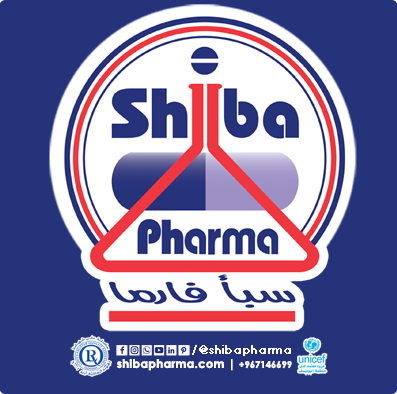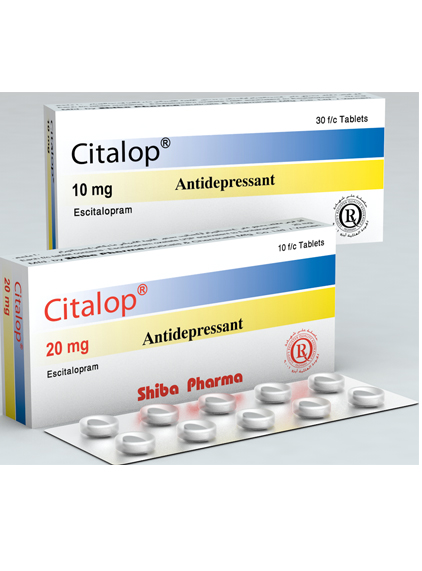Section :
Citalop
Citalop
COMPOSITION :
Each f/c tablet contains : Escitalopram Oxalate USP equivalent to Escitalopram 10 mg , 20mg.
DESCRIPTION :
Citalop (Escitalopram) is an antidepressant drug. It is the most selective serotonin reuptake inhibitor (SSRI) especially serotonin (5-HT). Escitalopram is absorbed completely from the gastrointestinal tract and independent of food intake, and the maximum plasma concentration is reached 4 hours after multiple dosing . The absolute bioavailability is about 80% and less than 80% of Escitalopram bind with plasma protein and it is metabolised in the liver and the elimination half life is about 30 hours. It is excreted by both hepatic and renal routes.
INDICATIONS :
Citalop is used for treatment of :
- Depression.
- Panic disorder with or without agoraphobia.
- Social and generalized anxiety disorder.
- Obsessive - Compulsive Disorder (OCD).
DOSAGE AND ADMINISTRATION :
Citalop is administered as a single daily dose and may be taken with or without food .
- Adults :
• Depression : The usual dose is 10 mg once daily. Depending on patient response, the dose may be increased to a maximum of 20 mg.
Usually 2 - 4 weeks are necessary to obtain antidepressant response and after the symptoms resolve, treatment for at least 6 months is required for consolidation of response.
• Panic disorder with or without agoraphobia : An initial dose of 5 mg once daily is recommended for the first week before increasing the dose to 10 mg. The dose may be further increased up to a maximum of 20 mg daily depending on individual patient response . Maximum effectiveness is reached after about 3 months.
• Social and Generalized anxiety disorder : The usual dose is 10 mg once daily. Usually 2 - 4 weeks are necessary to obtain symptoms relief. Depending on patient response, the dose may be decreased to 5 mg or increased to a maximum of 20 mg daily.
• Obsessive-Compulsive Disorder : The initial dose is 10 mg once daily. Depending on the individual patient response, the dose may be increased to a maximum of 20 mg.
- Elderly patients (above 65 years of age) :
The initial dose is 5 mg once daily. Depending on patient response, the dose may be increased to 10 mg daily.
- Children and adolescents (<18 years) :
Ecitalopram should not be used in the treatment of children and adolescents under the age of 18 years.
- Renal impairment patients :
Dosage adjustment is not necessary in patients with mild to moderate renal impairment. Caution is advised in patients with severe reduce in renal function (Creatinine Clearane < 30 ml / min.).
- Hepatic impairment patients :
An initial dose of 5 mg once daily for the first two weeks of the treatment is recommended in patients with mild to moderate hepatic impairment. Depending on individual patient response, the dose may be increased to 10 mg daily. Caution is advised in patients with severe reduce in hepatic function.
RESTRICTIONS ON USE : Contraindications
- Known hypersensitivity to Escitalopram.
- Concomitant use of Escitalopram with monoamine oxidase inhibitors (MAOIs).
- Patients with known QT interval prolongation or patients taking drugs that prolong the QT interval. Precautions
- Epilepsy or a history of such disorders (treatment should be avoided if the epilepsy is poorly controlled and the treatment should be stopped if seizures develop or when there is an increase in frequency).
- Diabetic patients, so the dosage of insulin and/or oral hypoglycemic drugs may need to be adjusted.
- Severe liver or renal impairment.
- Hyponatraemia that caused by other medications .
- Mania (treatment should be discontinued if patient entering manic phase).
- Suicidal thoughts are common in depressed patients . So patients should be closely monitored during early therapy until significant improvement is observed.
- Escitalopram should be withdrawn gradually over a period of at least one to two weeks to reduce the risk of withdrawal symptoms during dosage reduction or stopping treatment.
Withdrawal common sympotms include : dizziness, confusion, nausea, vomiting, headache , sweating , anxiety, sleep disturbances, emotional instability, irritability and visual disturbances.
- The risk of subcutaneous bleeding may increase in patients who are taking Escitalopram with medicines that affect the rate of clotting of the blood such as aspirin , some antipsychotics , tricyclic antidepressants or oral anticoagulants.
Effects on the capacity to drive vehicles or use machines
Generally, Escitalopram does not impair the alertness but if patient feels dizzy or sleepy when starts taking the medicine, he should avoid driving vehicles or using machines. Use in pregnancy and lactation
Escitalopram should not be used during pregnancy unless clearly necessary and because it may excreted into breast milk, breast-feeding is not recommeded during treatment.
DRUG INTERACTIONS :
- Using of Escitalopram with other antidepressants such as selegiline (selective MAO-B inhibitor) may lead to serotonin syndrome . In case of moclobemide (selective MAO-A inhibitor), the patients should stop using Escitalopram for 7 days before starting moclobemide.
- Caution should be taken when Escitalopram used with lithium and tryptophan.
- Coadministration of Escitalopram with omeprazol and cimetidine lead to increase the plasma concentration of Escitalopram.
- Coadministration of Escitalopram with drugs that prolong the QT intervals such as antiarrythmics, antipsychotics, antimicrobial agents, antihistamin .
- Concomitant use of Escitalopram with anticoagulant or drugs known to affect platelet function (eg. some antipsychotic drugs, tricyclic antidepressants, acetylsalicylic acid, non-steroidal anti-inflammatory drugs).
- The blood levels of imipramine and metoprolol are increased when used with Escitalopram.
- Concomitant use of Escitalopram with St-John’s wort herb (hypericum perforatum) may increase the risk of side effects.
SIDE EFFECTS :
The side effects are often mild and usually disappear after few days of treatment .
- Common side effects are dry mouth, sinusitis, increased sweating, agitation, decreased appetite, feeling sleepy, insominia, dizziness, yawning, diarrhoea, constipation, nausea, vomiting, fatigue and sexual distrubances.
- The following side effects are very rare but serious and if they appear the doctor should be consulted immediately :
• Hyponatraemia .
• Serotonin syndrome as high fever, agitation, confusion, trembling and abrupt contractions of muscles.
• Abnormal liver function test.
• Hallucinations, mania and anxiety.
OVERDOSAGE :
Symptoms of Escitalopram overdose mainly related to the central nervous system which include : dizziness, tremor, agitation, convulsion and coma. And other symptoms include : nausea, vomiting, tachycardia, QT interval prolongation, arrhythmia, hypokalemia and hyponatraemia . There is no specific antidote for Escitalopram but the treatment of overdose involves appropriate symptomatic and supportive therapy including the maintenance of clear airways and monitoring of ECG and vital signs. Activated charcoal should be considered and gastric lavage should be carried out as soon as possible.
STORAGE INSTRUCTIONS :
Store below 30°C, in a dry place . Protect from light.
PRESENTATION :
Citalop 10 : Pack of 30 tablets and hospital packs of different sizes. Citalop 20 : Pack of 10 tablets and hospital packs of different sizes.
INSTRUCTIONS TO THE PATIENT
- Medicament is a product which affects your health, and its consumption contrary to instructions is dangerous for you.
- Follow strictly the doctor’s prescription, the method of use and the instructions of the pharmacist who sold the medicament.
- The doctor and the pharmacist are experts in medicine, its benefits and risks.
- Do not by yourself interrupt the period of treatment prescribed for you.
- Do not repeat the same prescription without consulting your doctor.
Keep medicament out of reach of children Mfd. By
P.O. Box : 4265 Sana’a /Yemen.
Council of Arab Health Ministers


